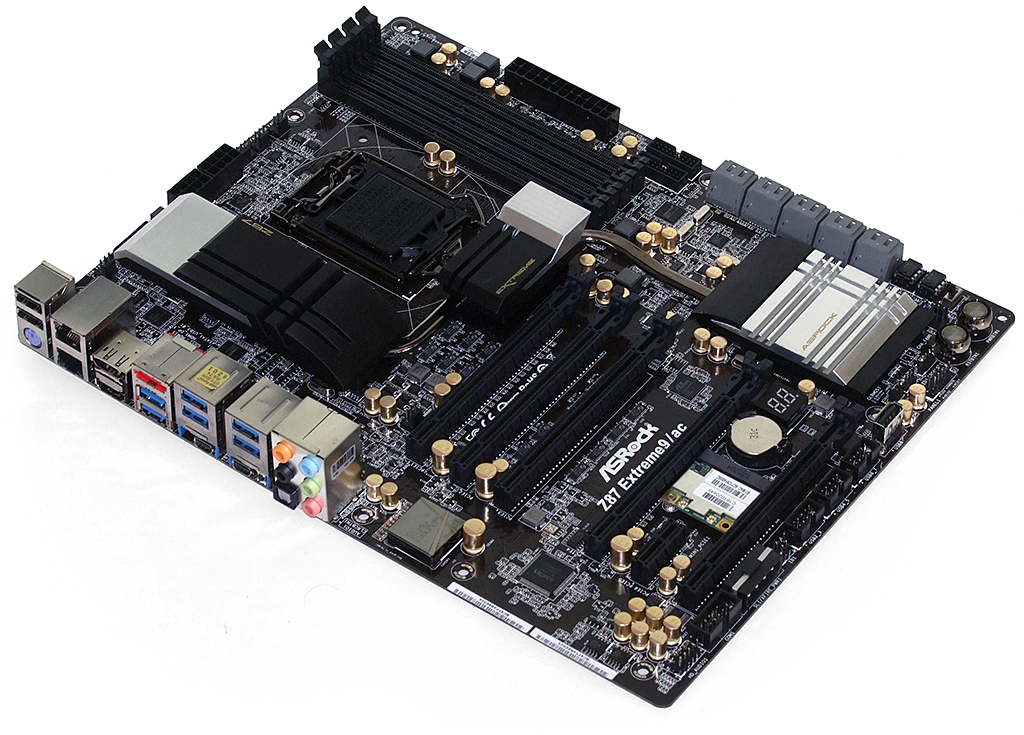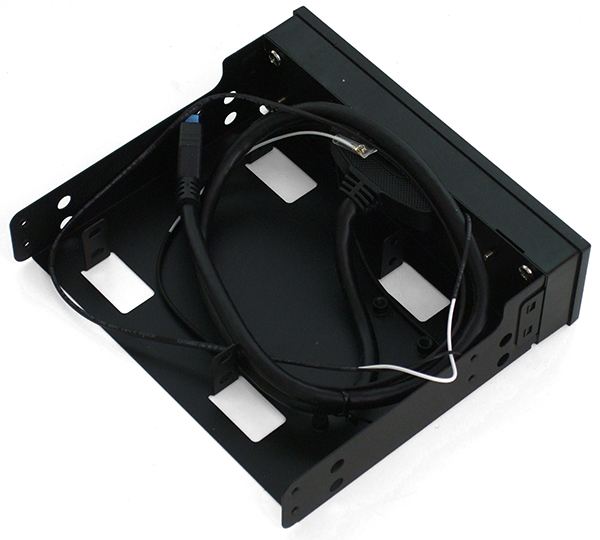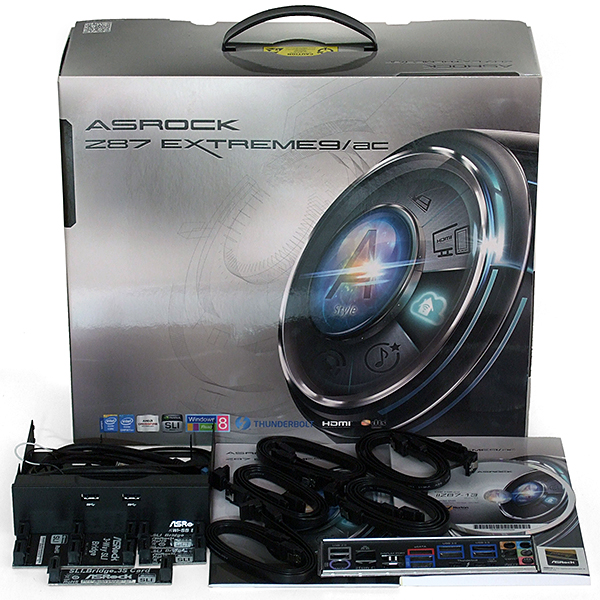Four Z87 Express Motherboards For Three- And Four-Way SLI
Formerly a very exclusive component, the PCI Express switch that makes Intel’s LGA 1150-based platforms three- and four-way SLI-capable is now available across a range of high-end motherboards. Today we compare four premium enthusiast-oriented models.
ASRock Z87 Extreme9/ac
Why you can trust Tom's Hardware
ASRock hides its two Thunderbolt interfaces under four USB 3.0 ports, maintaining enough room to stick a CLR_CMOS button next to one of them as well. The full-sized DisplayPort connector passes an external signal through to a Thunderbolt port; the HDMI connector can be used for another display.
Both GbE ports interface with Intel controllers to support teaming mode, and ASRock also adds Broadcom’s 802.11ac-capable mini-PCIe card for wireless networking. Those are features that could make the Z87 Extreme9/ac perfect in an enthusiast's principal workstation. We only seem to be missing antenna connectors on the rear I/O panel...
Instead, we get a plastic-faced 5.25” adapter tray, which replaces the firm’s familiar 3.5” USB 3.0 bay adapter, to host internal wireless antennas in addition to a pair of USB 3.0 ports. The bay adapter we knew so well could take a 2.5” SSD internally. In this version, it's able to accept a pair of solid-state drives. But if you want to swap out the internal antennas for high-gain or directional alternatives, you'll have to find yourself a slot adapter for the back of the board. This shouldn't be an issue unless you're fighting for more range.
The second x16 slot is wired directly to the CPU; using it bypasses the PEX8747 PCIe 3.0 bridge and all four corresponding x16-length slots. Though we see four dual-lane pathway switches beneath that slot, ASRock tells us that there's no way to go CPU-direct for x8 and x8 two-way configurations. If you want to use two cards, you instead need to go x16 and x16 using PLX Technology's switch, and slots one and four. The company's bundled SLI bridge supports that spacing arrangement.
Other layout features include a second eight-pin EPS12V connector to feed extra current to the 12-phase voltage regulator (if desired), a second front-panel USB 3.0 header behind the first header at the front edge for easy four-port front-panel configuration, an extra four forward-facing SATA 6Gb/s ports (totaling 10), a second replaceable BIOS I/C, and an extra USB 2.0 port that fits external drives.
Other than the lack of external Wi-Fi antenna connectors, the only insurmountable layout problem is a front-panel audio header that’s a little too far back in the bottom-rear corner to fit the short cables of some cases.
My assumption when I started writing this story was that once the pieces were in place to support three-way SLI, accommodating four cards should be easy. ASRock's Z87 Extreme9/ac doesn’t include a four-way SLI bridge however, instead requiring you to connect the first card to the second, the third to the fourth, and the fourth to the second using separate bridges. This arrangement is illustrated in the company's user manual.
What you do get is a three-way SLI bridge, ten internal SATA cables, and the previously-mentioned bay adapter, which includes two front-panel USB 3.0 ports, an internal Wi-Fi antenna, and support for up to two 2.5” SSDs.
Current page: ASRock Z87 Extreme9/ac
Prev Page Making Z87 Express Three-Way SLI-Capable Next Page Z87 Extreme9/ac SoftwareGet Tom's Hardware's best news and in-depth reviews, straight to your inbox.
-
iam2thecrowe Am i missing something here? I dont see the point of reviewing 3 and 4 way sli boards and not testing 3 and 4 way sli. Seems rather pointless since any average motherboard will perform well in adobe, productivity etc benches dependent on the cpu....Reply -
Crashman This was really just about finding any board that supports Nvidia's requirements about how that third card is connected. We found some, I overclocked them, now I have enough data to pick a board for the System Builder Marathon. But that only explains why overclocking took priority!Reply
After spending two days per board on a "one week" article, I couldn't add more tests. The general benchmark set looks for unintended overclocking/underclocking, power and memory bandwidth issues, so you can see the performance difference attributable to each board's CPU and DRAM configuration differences. It runs from a .bat file, so it didn't add significantly to the article's completion time.
The PLX bridge that these all share represents the "great equalizer" when it comes to CrossFire and SLI configuration, so that portion of all three boards should be identical. I understand that things that should be the same in theory are occasionally different in practice. My apologies for not having the extra 1-day per board for additional tests. -
iam2thecrowe Reply12341788 said:They all use the same PLX bridge, so you would have seen a whole bunch of identical gaming results. The general benchmark set looks for unintended overclocking/underlocking, power and memory bandwidth issues, so you can see the actual performance difference. And there's still an overclocking section.
These boards had to be tested for general performance and stability like any other boards. The PLX controller is the equalizer when it comes to games.
I think testing 3/4 way sli would still be valid, as it doesn't always work properly, in the past there have been compatibility problems with certain gpu's/boards/firmware/controllers and certain benchmarks completely failed. -
Kraszmyl "internally-mounted external USB 2.0 port for ReadyBoost fanatics" on the asus z87.Reply
Those have nothing to do with readyboost. The internal usb ports are very common on workstations and you put CAD dongles and equivalent items in them so that you can lock them inside the case and don't have to worry about some one stealing them from the outside or them taking up an outside usb port. -
Memnarchon I would love to see Asus Maximus VI Extreme, but it seems ASUS didn't want to give a 2nd board and prefered the Z87 WS....Reply -
Traciatim where are the sli/crossfire benchmarks and comparisons with traditional non-switched setups?Reply
Hey guys, we have these awesome new setups for supreme graphics pumping power! Watch it zip files like every other board! -
duramax08 Why are they still making motherboards with PS/2 connections? Its time to move on, replace those baby's with some USB 3.0!Reply




